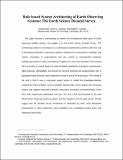| dc.contributor.author | Selva, Daniel | |
| dc.contributor.author | Crawley, Edward F. | |
| dc.contributor.author | Cameron, Bruce Gregory | |
| dc.date.accessioned | 2015-05-07T12:53:53Z | |
| dc.date.available | 2015-05-07T12:53:53Z | |
| dc.date.issued | 2014-03 | |
| dc.date.submitted | 2013-09 | |
| dc.identifier.issn | 0022-4650 | |
| dc.identifier.issn | 1533-6794 | |
| dc.identifier.uri | http://hdl.handle.net/1721.1/96924 | |
| dc.description.abstract | This paper presents a methodology to explore the architectural trade space of Earth observing satellite systems, and applies it to the Earth Science Decadal Survey. The architecting problem is formulated as a combinatorial optimization problem with three sets of architectural decisions: instrument selection, assignment of instruments to satellites, and mission scheduling. A computational tool was created to automatically synthesize architectures based on valid combinations of options for these three decisions and evaluate them according to several figures of merit, including satisfaction of program requirements, data continuity, affordability, and proxies for fairness, technical, and programmatic risk. A population-based heuristic search algorithm is used to search the trade space. The novelty of the tool is that it uses a rule-based expert system to model the knowledge-intensive components of the problem, such as scientific requirements, and to capture the nonlinear positive and negative interactions between instruments (synergies and interferences), which drive both requirement satisfaction and cost. The tool is first demonstrated on the past NASA Earth Observing System program and then applied to the Decadal Survey. Results suggest that the Decadal Survey architecture is dominated by other more distributed architectures in which DESDYNI and CLARREO are consistently broken down into individual instruments. | en_US |
| dc.description.sponsorship | "La Caixa" Foundation | en_US |
| dc.description.sponsorship | Charles Stark Draper Laboratory | en_US |
| dc.description.sponsorship | Goddard Space Flight Center | en_US |
| dc.language.iso | en_US | |
| dc.publisher | American Institute of Aeronautics and Astronautics | en_US |
| dc.relation.isversionof | http://dx.doi.org/10.2514/1.a32656 | en_US |
| dc.rights | Creative Commons Attribution-Noncommercial-Share Alike | en_US |
| dc.rights.uri | http://creativecommons.org/licenses/by-nc-sa/4.0/ | en_US |
| dc.source | MIT web domain | en_US |
| dc.title | Rule-Based System Architecting of Earth Observing Systems: Earth Science Decadal Survey | en_US |
| dc.type | Article | en_US |
| dc.identifier.citation | Selva, Daniel, Bruce G. Cameron, and Edward F. Crawley. “Rule-Based System Architecting of Earth Observing Systems: Earth Science Decadal Survey.” Journal of Spacecraft and Rockets 51, no. 5 (September 2014): 1505–1521. | en_US |
| dc.contributor.department | Massachusetts Institute of Technology. Department of Aeronautics and Astronautics | en_US |
| dc.contributor.department | Massachusetts Institute of Technology. Engineering Systems Division | en_US |
| dc.contributor.mitauthor | Selva, Daniel | en_US |
| dc.contributor.mitauthor | Cameron, Bruce Gregory | en_US |
| dc.contributor.mitauthor | Crawley, Edward F. | en_US |
| dc.relation.journal | Journal of Spacecraft and Rockets | en_US |
| dc.eprint.version | Author's final manuscript | en_US |
| dc.type.uri | http://purl.org/eprint/type/JournalArticle | en_US |
| eprint.status | http://purl.org/eprint/status/PeerReviewed | en_US |
| dspace.orderedauthors | Selva, Daniel; Cameron, Bruce G.; Crawley, Edward F. | en_US |
| dc.identifier.orcid | https://orcid.org/0000-0002-7618-5182 | |
| mit.license | OPEN_ACCESS_POLICY | en_US |
| mit.metadata.status | Complete | |
